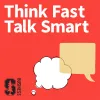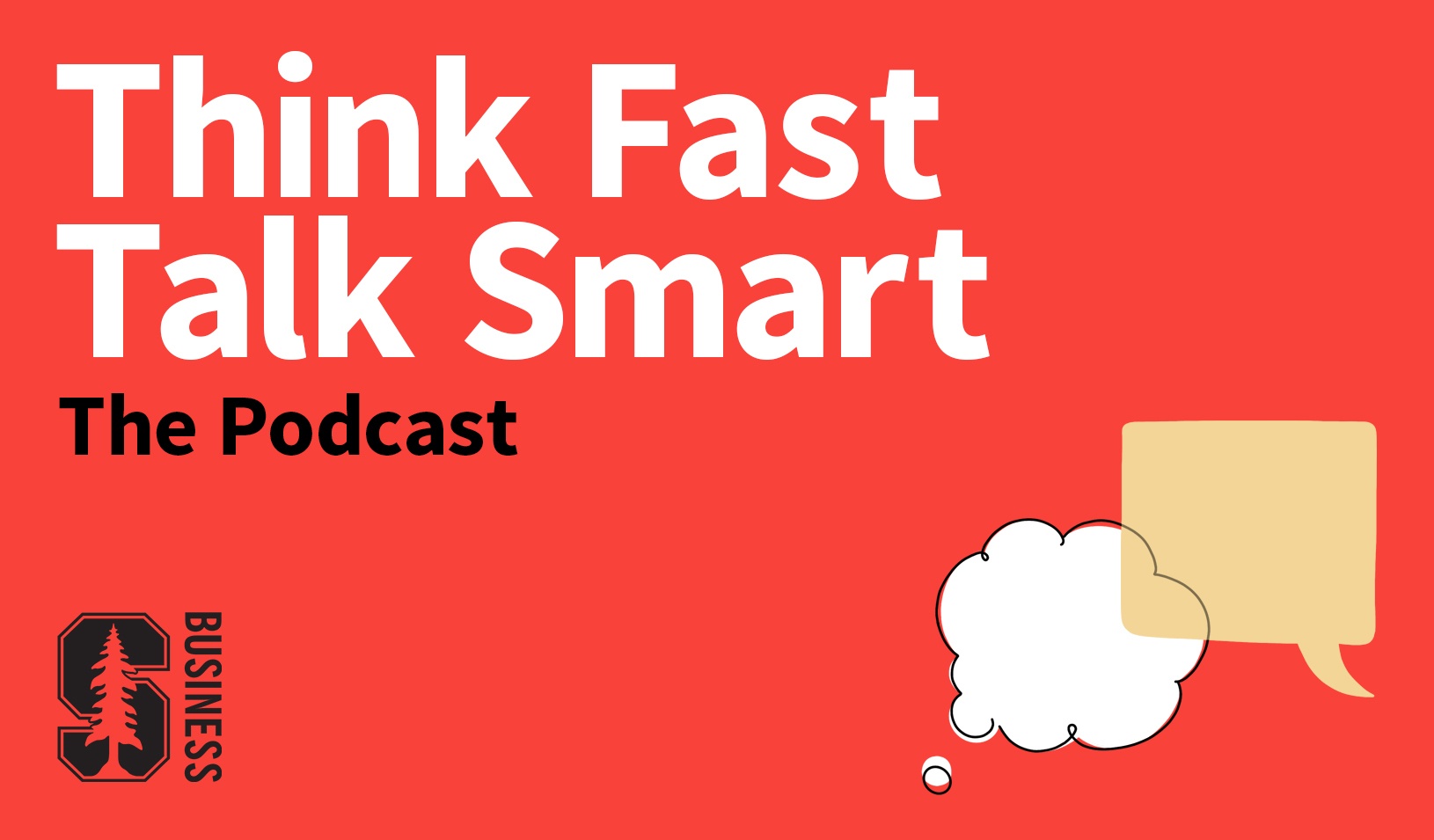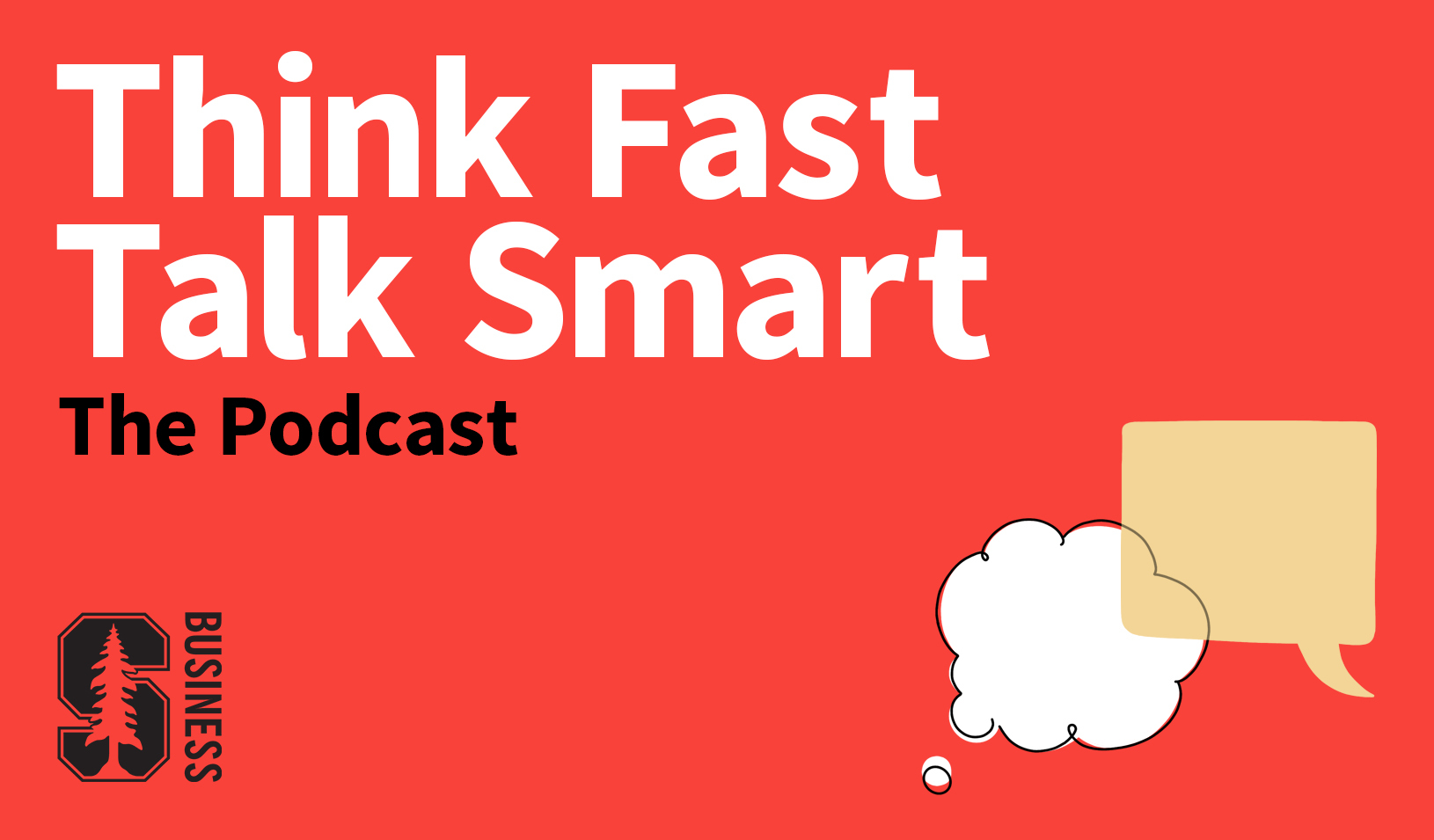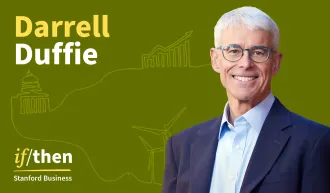Simple Is a Superpower: How to Communicate Any Idea to Any Audience
In this episode, Carmine Gallo shares how intentional, straightforward messaging helps you connect with others and get things done.
August 22, 2023
The best communicators express ideas simply. And to do that, says Carmine Gallo, “you have to connect with people in a language they understand.”
Gallo is an author, communication coach, and lecturer at the Harvard Graduate School of Design. For him, the cornerstone of good communication is empathizing with an audience enough to truly speak their language. “Think about the audience first,” Gallo says. “If you cannot speak the same language to different stakeholders and adapt the language for those different stakeholders, you’ll never get anything done.”
On this episode of Think Fast, Talk Smart, Gallo and host Matt Abrahams discuss how we can simplify our language and weave relevant stories to translate and tailor our communication for our audience.

Listen & Subscribe
Think Fast, Talk Smart is a podcast produced by Stanford Graduate School of Business. Each episode provides concrete, easy-to-implement tools and techniques to help you hone and enhance your communication skills.
Full Transcript
Matt Abrahams: The best communicators spend the most time honing their communication. They work on storytelling, understanding their audience, making their content relevant. Today we’ll explore what’s involved in becoming a great communicator. I’m Matt Abrahams, and I teach Strategic Communication at Stanford Graduate School of Business. Welcome to Think Fast, Talk Fast: The Podcast. Today I’m looking forward to speaking with Carmine Gallo. Carmine is the Founder and CEO of Gallo Communications.
Welcome, Carmine. I’m super excited to chat with you, and thanks for being here.
Carmine Gallo: Matt, thank you. Thanks for inviting me. Congratulations on the success of your podcast. I have been an eager fan of this podcast because I’ve loved so many of your interviews. It’s very hard to stand out, and it seems as though you’ve been standing out by helping others stand out.
Matt Abrahams: Well, thank you. I appreciate that, and I’m excited to hear what we have to talk about today, so let’s get started. I know you spend a lot of time helping leaders communicate more effectively. One of the things you talk about is leaders are often translators. And I’d for you to share with our listeners what that means for you because I wholly agree; I think that’s exactly right. Help us understand how a leader is a translator, and what are some things people can do to be better translators?
Carmine Gallo: In order for anyone to take action on your ideas, in order for you to persuade — persuasion simply means combining words and ideas to move people to action — requires that the listener understands clearly the desired action. You’re often speaking, depending on your field, in a very different language. Even if you’re speaking to someone who’s speaking the same language; that’s not the point. You’re using words and complexity and jargon and shortcuts, abbreviations and acronyms that your listener doesn’t understand simply because they’re not in the same field.
Let me give you an example. I think this is the best way of describing what a translator is. I’m going to give you an example that I’ve been thinking about since I’ve been booked for your podcast because it just happened recently.
Matt Abrahams: Mm-hmm.
Carmine Gallo: I spoke to a prominent global scientist. Her name is Annie Kritcher. She plays a crucial role in a recent headline-grabbing experiment in what’s called fusion, which is replicating the sun’s power for renewable energy. She lives in my area in California, and she was recently named to Time magazine’s List of the 100 Most Influential People of the Year, a very prominent scientist in STEM and an advocate for women in science. So I caught up with her and I asked her, “Please explain in plain English to a nonscientist, what is it that you achieved?” because they made, again, this headline-grabbing experiment.
What she said is — here’re exactly her words: “Carmine, we’re bringing the same process that powers the sun to the earth to harness the energy in a controlled setting. It’s important because it’s the Holy Grail of the clean energy future.” Anyone can understand that and understand that she was using metaphors like, “It’s the Holy Grail,” “harnessing the power of the sun, bringing it to earth.” Simple, understandable. I took the transcript from our conversation. I put it into a generative AI tool, and it said that it was understandable to an eighth grader, a 13- to a 15-year-old.
I went back to Annie and I said, “Annie, do me a favor. How would you explain it to a peer? How would you explain this experiment to a peer?” Without missing a beat, because it’s so easy for her to do it, she said, “Oh, that’s easy. We were able to achieve ignition, a rapid increase in [Deuterium-tritium] temperature associated with alpha particle self-heating by increasing the hotspot plasma energy density.” And I had to read that from a paper because there’s no way I could remember that. I was blown away. Matt, I was like, oh my goodness, it’s a completely different language. On the fly, she could translate this incredibly complex science experiment and this milestone in science. She can translate it depending on her audience.
And I asked her, “How were you able to do this?” She said, “I didn’t learn it in school,” which is why we need podcasts like this. You don’t learn this stuff in school. But she said, “Communication is the number one skill leaders need to align teams around a bold mission.” Matt, if you cannot explain the science to get buy-in from investors, stakeholders, peers, agencies, regulators, government, if you cannot speak the same language to different stakeholders and adapt the language for those different stakeholders, you’ll never get anything done.
Matt Abrahams: Thank you so much for sharing that example, Carmine. That is a classic, crystal-clear example of the power of translation. She knew her audience and was able to adjust. She used a tool like an analogy to help all of us. As leaders, in our roles, we need to think about how we can make our content accessible so that people understand us. So thank you for sharing that. I’d like to turn our attention to some of your many books. In your book, “Talk Like TED,” which is a great helpful read, your subtitle specifies that you identify “The Nine Secrets of the World’s Top Minds.” Would you mind sharing with us one or two of those secrets? And how can we use those to help our communication?
Carmine Gallo: “Talk Like TED” was a book that I wrote based on conversations with famous TED speakers. So it’s not necessarily a book on how to get on a TED stage, how to fill out the form and become a TED speaker. It’s what can we learn from some of the world’s great speakers who have taken a TED stage in addition to leading organizations or their teams. And one thing in particular became storytelling, which is something that I know you’ve covered in your podcast. I know that it’s something that you teach at Stanford. Storytelling is fundamental to not only the way we communicate as humans but to giving a TED talk or any powerful presentation.
So one of the TED commandments, as they’re really called — TED commandments — these are the guidelines for anyone who wants to speak on a TED stage, is to not necessarily start with a story, although most people do, but it’s to tell stories, personal stories, because stories inform, they illuminate, educate. I think one of the best examples of storytelling is Bryan Stevenson. Bryan is a famous human rights attorney who gave a very famous TED speech. I talked to him after his TED talk. Seventy percent of his TED talk was just personal stories, anecdotes from the people he’s met, the people he’s helped, or other folks that he has met and how they created his personality and fueled his passion for human rights and what he does.
And so I asked him, “Why do you tell so many stories in your presentations?” And remember, this is a guy who wins cases before the U.S. Supreme Court, so he knows how to persuade. And he said, “Carmine, you have to tell stories to break down barriers between people because it’s through personal stories that we connect with one another as humans.” A lot of professionals, maybe people listening to this podcast, get confused, I think, when we talk about storytelling. They say, “Well, I’m not a novelist. I’m not a screenwriter. How does storytelling apply to me?” Well, as a species, we’re storytellers. It’s in our DNA. It’s universal across culture, across languages, across countries.
You are a storyteller first. What happens when we create PowerPoints? All of a sudden, we lose our sense of story. It’s all about bullet points and inserting text and getting the right photo or image or using the right font. We forget the narrative. I believe anyone who wants to aspire to a leadership position or career advancement or actually wants to get something done, understand that you’re a storyteller first. PowerPoint comes after. PowerPoint or a presentation complements the story, but you have craft the narrative first. That’s the big lesson I learned from the great TED speakers.
Matt Abrahams: I’m smiling as you say that because, almost word for word, I find myself saying the same thing — story first, story first. And the notion that story is built into being human, absolutely accurate. And I really liked how you said that story bridges and connects us to other people. I encourage the people I work with, the students I teach to tell me, what’s the story you’re telling here, to get them to frame it as a story rather than just a list of facts and a list of ideas.
While many of your books, Carmine, address influence and persuasion, a topic that our listeners are very interested in, your book “Five Stars” dives deeply into persuasion. I have a specific angle I’d like you to talk about when it comes to persuasion. How do you encourage people to be more effective in their persuasion in the midst of resistance, hesitation, and concern about what it is you’re trying to persuade people on?
Carmine Gallo: One of the reasons why I focus on storytelling is exactly what Bryan Stevenson told me: You’re most likely going to be speaking to people who are resistant to change, so that’s why you have to use tools and vehicles that connect one another and lower barriers between people. That’s why storytelling, I think, is a fundamental aspect of persuasion. Storytelling, check. The other is to think about the audience first. It’s not about you. It’s about your audience. Reverse engineer — and I think you do this too, Matt; you’ve taught this — reverse engineer the presentation. Reverse engineer your pitch or your argument. What is the audience’s pain point? What keeps them up at night?
Whenever I speak to international audiences or I travel around and give keynote speeches, I bombard the organizers and the people responsible for those companies with a lot of questions ahead of time. I want to get into the heads of the audience. I need to know what keeps them up at night. And then I reverse engineer the presentation and my argument to help them. Here in Silicon Valley where I live, I talk to a lot of venture capitalists. And people come in with their pitch, and they’re enamored of their technology or how cool it is, or take a look at our demo, and they forget act one. They forget there’s a three-act structure to good storytelling. And act one is the setup, explaining the status quo. What is the problem with the status quo?
People like Steve Jobs were brilliant because they could show you problems that you didn’t even know you had until after his presentation. Then you realize I think I do need that Apple iPhone. That’s brilliant persuasion. But I think it’s audience first. And I’ve come to realize that very few people do that. They open their PowerPoint, they open their presentation and just start filling in information that’s important to them, or that’s exciting to them. Why should my audience care? As you’ve said, so what? My background is in journalism, and Journalism 101, first day of graduate school: Why should I care? That is the first question you ask. Why should your audience care about the topic? That’s the headline. Everything else feeds into the headline.
And so I suggest we reverse engineer presentations and pitches or any business proposal of any type. Why should your audience care? What’s their pain point? How is your idea or solution going to make their life better so everybody lives happily ever after? That’s reverse engineering the story.
Matt Abrahams: You’ve summarized so nicely what many of our podcast episodes have been about, which is really about structure in story and about knowing your audience. And what I hear you saying, the key to dealing with resistance and concern and hesitation is to make your argument, your persuasion relevant and salient to the audience and then work backwards from what their concerns are. And I love that concept of reverse engineering. And that’s very powerful and I think will go a long way to addressing the concerns that your audience might have.
You have two books about Steve Jobs, one exploring his approach to innovation and the other looking at his presenting. Your newest book, “The Bezos Blueprint,” is all about Jeff Bezos. By your accounts, both men were tenacious. They worked hard on their communication and had specific approaches to it. Can you highlight one or two communication principles that each of these gentlemen demonstrated and how we, reading your books and learning from you, could benefit from them?
Carmine Gallo: There’s a theme that runs throughout my books, whether it’s Steve Jobs or TED talks or a new one on Jeff Bezos. The theme that runs across my books is very clear to me now — maybe it wasn’t clear when I first started — is that effective communicators in any field have practiced the skill. Communication is, above all, a learned skill. Great communicators are made, not born. Steve Jobs was not born, nor was he early in his career, a charismatic stage presence like the Steve Jobs that people recall from 2007 when he introduced the iPhone. He became one of the greatest business storytellers of our time.
Jeff Bezos — I analyzed 24 years of his writing. As Amazon grew in complexity, his writing became simpler, more concise, easier to understand. And that’s intentional. That’s something that happens with both of these entrepreneurs because they’re intentional about improving and working on communication. So the theme that I have found — and it’s a valuable piece of advice for everyone — is that communication is a learned skill. Public speaking is a learned skill. The minute you think you know it all is the moment you stop growing.
I had a conversation with a famous astronaut, a Canadian astronaut named Chris Hadfield who gave a very famous TED talk. He’s called the singing astronaut — he sang a version of a David Bowie song while he was floating weightless in space. We were talking specifically about his TED talk, and he said, “You know, Carmine, it was interesting because I’ve been speaking as an astronaut for 25 years. I speak to Rotary Clubs and organizations and schools. The TED organizers gave me some tips on how to deliver a better presentation, and I learned a lot. That’s the point, Matt. Good communicators are learn-it-all’s. They’re constantly receptive to new ideas, new ways of communicating.
If you think you’re a good speaker, a good presenter and you don’t need any help, I’ll bet that you’re not nearly as effective as you think you are.
Matt Abrahams: This notion of continually developing and the desire to improve is something I see in all of the people I work with who have really improved and who are and are becoming good speakers. This desire to improve and being humble and giving yourself a little bit of grace to say that there are areas for improvement is really important. And I appreciate you highlighting that. I feel many people think that there’s some endpoint when it comes to developing communication skills. And I think what you’ve just shared with us is what I see all the time, that it’s a continual process.
Carmine, I’ve studied martial arts for a long, long time, and I very much remember when I received my first black belt. My instructor looked at me and said, “Congratulations. Now let’s get started.” And that to me was a very powerful moment because it reminded me that there’s always more to learn, and I think you’ve highlighted that with regard to communication. Thank you.
Carmine Gallo: I love that. What a great anecdote.
Matt Abrahams: Yeah. And it’s been one that’s motivated me for a long time. Before we end, Carmine, I’d like to ask you the same three questions I ask everyone who joins me. Are you up for that?
Carmine Gallo: Absolutely.
Matt Abrahams: Excellent. Question number one: If you were to capture the best communication advice you’ve ever received as a five- to seven-word presentation slide title, what would it be?
Carmine Gallo: Storytellers drive change and innovation.
Matt Abrahams: That one’s encapsulated so many of the things you talked about. It’s about storytelling. It’s about being persuasive and innovative. It’s about speaking in a way that makes your content accessible. Wonderful, wonderful summary in those five to seven words. Question number two — and this one I’ll be very curious to hear from you: Who is a communicator that you admire and why?
Carmine Gallo: I’ll give you a modern contemporary communicator that everyone around the world is going to know, and that’s the billionaire Warren Buffett. As we speak, I think he’s the third wealthiest person on earth. Warren Buffett is an intentional communicator. If you’ve read his shareholders letters, they’re models of simplicity. And he is an expert with using metaphor to explain complex financial ideas. So this idea of investing in companies or stocks that are surrounded by a moat, that originated from Warren Buffett, and now financial analysts use it every day on business news — “We like that company because it’s surrounded by a moat.”
Warren Buffett is very intuitive and understands that in order to express ideas simply, you have to connect with people in a language they understand, and that’s often metaphors and analogies that are familiar to them. So I would put Warren Buffett at the top of my list as a contemporary communicator.
Matt Abrahams: Warren Buffett has some wonderful sayings; he’s a great role model. And one of the things I admire most about him is he is out front saying the importance of communication. He says one of the best skills people can learn in their education, in practice is communication. So not only is he a good role model, he’s a good advocate for what you and I both do. Question number three: What are the first three ingredients that go into a successful communication recipe?
Carmine Gallo: Big picture before details.
Matt Abrahams: Mm-hmm.
Carmine Gallo: So again, think about your audience. What’s the big picture? What’s in it for them? Why should they care? Answer that in the first 60 seconds. Then they’ll be hooked for the rest of the movie. Get them to want to watch the movie first in the first scene. So big picture first. Big picture, then details. Second ingredient is storytelling. Reframe the way you see yourself as a communicator. You are not a PowerPoint presenter. You’re a storyteller. PowerPoint complements the story. And third — and something very important these days, more important than ever — we are bombarded by complexity and an overload of information.
Simplify, simplify, simplify. And maybe those were the three — simplify, simplify, simplify. They could have been the three.
Matt Abrahams: [Laughs] Simplify.
Carmine Gallo: Simplify by choosing simpler words, easier to understand explanations, less jargon, shorter words to replace bureaucratic language or convoluted words. I call simple the new superpower because I see how valuable it is. So big picture, storytelling, and simplicity. If you can master those three ingredients, you’ll be head and shoulders above the vast majority of business professionals.
Matt Abrahams: You’ve given us a very clear rubric to strive towards, this notion of start with the big picture; make sure that it’s relevant, audience specific, and tells a story; and then finally, make it simple and accessible. Wonderful advice, as is everything you’ve said, Carmine. It was such a pleasure not only to get to chat with you but to watch how you model and demonstrate the things that you talk about. Thank you so much. I appreciate your specific, actionable advice and guidance. And I wish you well with your new book.
Carmine Gallo: Thank you so much, Matt. I appreciate it, and I really appreciate the opportunity to speak to a receptive audience, people who get it, and they understand this skill and how important it is. So thanks again.
Matt Abrahams: Thanks for joining us for another episode of Think Fast, Talk Smart: The Podcast, from Stanford Graduate School of Business. This episode was produced by Jenny Luna, Ryan Campos, and me, Matt Abrahams. Our music was provided by Floyd Wonder. For more information and episodes, find us on YouTube or wherever you get your podcasts. Thank you, and please make sure to subscribe and follow us on LinkedIn.
For media inquiries, visit the Newsroom.
Explore More

Lose Yourself: The Secret to Finding Flow and Being Fully Present

Speak Your Truth: Why Authenticity Leads to Better Communication



